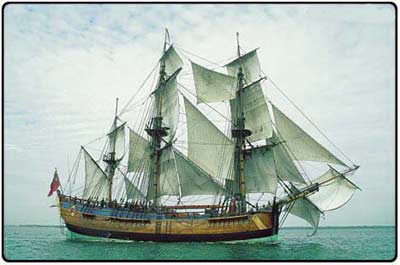Why Go Sailing?
Excerpted from Ocean
Spirit Magazine
| What is it about
sailing that hooks millions of otherwise sane and rational
people and causes
many of the symptoms of a love affair? Why do so many
of us willingly submit to the possibility of getting cold
and wet, tired and seasick, or even scared on occasion? |
The answers are as varied as the sailors you ask,
but it's only fair that I try to give you some idea of the background
and addictive properties of this wonderful sport before you
risk permanent infection by the sailing bug.
A timeless experience
One of the most powerful attractions of sailing
is its timelessness. Another is its simplicity. By learning
the art of handling a boat under sail, you are continuing a
practice that dates back thousands of years.
The skills are essentially the same as those
our ancestors used to explore the world.

HMS Endevour
Yes, today's boats are faster, safer, and more
comfortable than those of our predecessors, and life afloat
need not be a physical hardship, but the challenge of travelling
under sail and the rewards of a safe arrival are little changed
and still have few equals.
An ancient skill
Our seafaring ancestors would probably be astonished
at the idea of sailing solely for pleasure. For them it was
simply the only way to explore, conquer, and trade with the
rest of the world. For thousands of years, up until the invention
of the steam engine, the use of sails was the only alternative
to rowing and paddling. Now, while rowing and paddling are still
essential skills and can be great fun in small doses, it's easy
to see why a very enlightened (or lazy) person had the idea
of using a sail. In fact, lots of people seem to have had the
same idea. All over the world, different types of sailing boats
evolved to meet particular local needs. Whether the requirement
was to carry cargo or people along rivers, across shallow seas
or rough oceans, or to carry troops to invade the neighbours,
individual solutions were devised.
The successful ones proved their worth at sea
and the rest showed where there was room for improvement. The
builders and sailors who created and manned these craft developed
the skills of design, seamanship, and navigation that stretch
in an unbroken line to us today.
A sport was born
In the 16th and 17th centuries, Holland was the
most powerful seafaring nation in the world, with a huge fleet
of
sailing ships that maintained the country's trade links with
Africa, India, and Southeast Asia.
A particular type of small, light, and fast ship
was known
as a jaght, from the Dutch word jaghen, which means to
pursue or chase. These ships were normally used for
transportation and communication in Holland's sheltered
waters but, sometimes, their wealthy owners used them for
pleasure sailing. In 1660, the English king, Charles II, was
given a Dutch jaght and the words Yacht and Yachting
entered the English language.

A year later, English shipbuilders had taken
up the challenge of improving the Dutch design. The Peu brothers
presented the Catherine to King Charles and the Anne to his
brother, the Duke of York.
Then, as now, boys and their new toys meant a
race. In this case, a race down the River Thames from Greenwich
to Gravesend and back. The King won this first recorded competition
between two yachts, which was perhaps fortunate or he may have
banned the sport before it began. By the early 19th century,
the practice of yachting for pleasure and competition was established
among English gentlemen led by the Prince Regent, later to become
George IV. From small, if royal, beginnings the idea of sailing
for pleasure quickly spread overseas. Today, the International
Sailing Federation has 121 member countries, each with their
own national organization for the management and development
of the sport.

